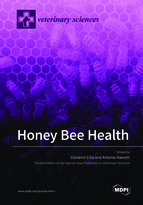Honey Bee Health
A special issue of Veterinary Sciences (ISSN 2306-7381).
Deadline for manuscript submissions: closed (30 September 2020) | Viewed by 106519
Special Issue Editors
Interests: honey bee; small hive beetle; invasive pest; trypanosomatids; honey bee virus; deformed wing virus; kashmir bee virus; replicative virus; strand-specific rt-pcr
Special Issues, Collections and Topics in MDPI journals
Interests: honeybee; nosemosis; bee health
Special Issues, Collections and Topics in MDPI journals
Special Issue Information
Dear Colleagues,
Over the past decade, the worldwide decline of honeybee populations has been important because of its implications for beekeeping and honey production. Honeybee pathologies are continuously studied by researchers to investigate the host–parasite relationship and its effect on honeybee colonies. For these reasons, the interest of the veterinary community has increased recently, and honeybee health has also become a subject of public interest.
Bacteria, such as Melissococcus plutonius and Paenibacillus larvae, microsporidia, such as Nosema apis and Nosema ceranae, fungi, such as Ascosphaera apis, mites, such as Varroa destructor, predatory wasps, including Vespa velutina, and invasive beetles, such as Aethina tumida, are “old” and “new” subjects of important veterinary interest. Recently, the role of host–pathogen interactions in bee health has been included in a multifactorial approach to the study of these insects’ health, which involves a dynamic balance among a range of threats and resources interacting at multiple levels.
The aim of this Special Issue is to explore honeybee health through a series of research articles focused on different aspects of honeybee health at different levels, including molecular health, microbial health, population genetic health, and the interaction with invasive species that live in strict contact with honeybee populations.
Dr. Giovanni Cilia
Dr. Antonio Nanetti
Guest Editors
Manuscript Submission Information
Manuscripts should be submitted online at www.mdpi.com by registering and logging in to this website. Once you are registered, click here to go to the submission form. Manuscripts can be submitted until the deadline. All submissions that pass pre-check are peer-reviewed. Accepted papers will be published continuously in the journal (as soon as accepted) and will be listed together on the special issue website. Research articles, review articles as well as short communications are invited. For planned papers, a title and short abstract (about 100 words) can be sent to the Editorial Office for announcement on this website.
Submitted manuscripts should not have been published previously, nor be under consideration for publication elsewhere (except conference proceedings papers). All manuscripts are thoroughly refereed through a single-blind peer-review process. A guide for authors and other relevant information for submission of manuscripts is available on the Instructions for Authors page. Veterinary Sciences is an international peer-reviewed open access monthly journal published by MDPI.
Please visit the Instructions for Authors page before submitting a manuscript. The Article Processing Charge (APC) for publication in this open access journal is 2600 CHF (Swiss Francs). Submitted papers should be well formatted and use good English. Authors may use MDPI's English editing service prior to publication or during author revisions.








